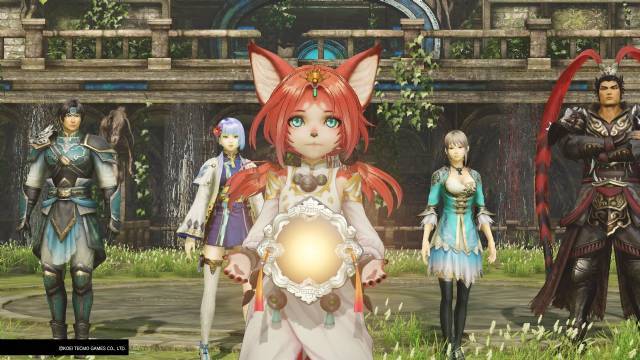The Throne of S … org
We start from the most difficult thing when it comes to crossover : the plot. Joining in a decent way narrative universes and characters so far between them is always difficult. The solution was the most obvious: the parallel universe. In this land where humans have cats and canines, the destinies of the world are straightened by the magical source of life. Linked to the physical person of the monarch, when the latter suddenly dies, the struggle for succession between Tamaki, Shiki and Setsuna is lit.
It is just Tamaki, in the face of the decay of the Source and the whole earth, to call on Heroes from another world to help them avoid apocalypse. The thing is only halfway through: the warriors are scattered on the continent, ending with the advantage of the other two contenders.
Although not memorable, the plot really has nothing objectively defective. Surely less pretestuous than Warriors Orochi’s travels, there is a classic fight for the throne. Each claimant will be supported by different heroes, which will require more than one campaign to get a complete picture.
Likewise, the plot also offers variations in interlacing. This results in different finals depending on the choices made, the recruited heroes or the battle fought. What may leave me perplexed is the narrative tone: the seriousness of the subject is dampened by the lush scene and the feline aesthetics of the original characters. The tone is very “Japanese soul”, so swinging between serious and faceted. And this is the evidence of many battles in which we try to give more depth to the interpersonal bonds between the Heroes. Inevitable that in this amalgam any epic tone loses its impact.
The continent and the source
The structure of the game is deeper than the average of the genre. The battles are in fact distributed in a map of generous proportions. Each of them belongs to very specific categories: those with the crystal icon forward the main plot, the fortresses unlock new portions of the map, and those with the portrait serve to recruit new heroes. There is also a lack of temporary battles, which are randomly displayed and often provide additional materials.
In fact, the design of the game revolves around the personalization of heroes: each one has its own Hero Cards, papers that need to be equipped and guarantee bonuses and enhancements of features, editable with the materials above.
The more accessible the two-weapon system, its importance grows exponentially with the difficulty that the campaign plays. Progression therefore becomes very discretionary, but at the same time very subversive: a campaign can be concluded in relatively short time.
The battles, however, live up and down. Much more set on winning strategic points, they speed up progression. To take them, the player is required to choose a group of five characters: the Leader will be the one directly controlled, while the others will be supportive. In addition to fighting in the clash, they will also be recalled through the digital cross or employable in collective moves.
But even without them, you can not say that the destructive potential of the player is little: Warriors All-Stars is the mosou that perhaps most of all exalt him. With few efforts it allows him to open literally in two opposing armies, increasing the counter of defeats often and willingly over a thousand. If farmingyou can never go around, grinding is eliminated by introducing an arena for practice, where you get to level up the characters by paying a fair price (which will never be a big deal).
All support structures will be focused on Spring, which will also act as a hub to improve the links between the heroes and activate various dialogues; although it is obvious the exaltation of transforming the favorite Tecmo-Koei character into a one-man army , there is also the feeling that this is all too easy and repetitive.

